An open access article entitled “Evaluation of disinfection efficiency in pet’s hospital by using chlorine dioxide” was recently published in Sustainable Environment Research. In this study, the authors investigated the efficacy of chlorine dioxide in reducing the concentration of bacteria and fungi in bioaerosols in an animal hospital. Chlorine dioxide is an effective disinfectant commonly used in water treatment and bleaching of wood pulp. It is effective against bacterial spores and was used to treat buildings after the 2001 anthrax attacks, also known as “Amerithrax.”



This study used culture based methods to assess efficacy. It would also be interesting to see if there is any taxonomic bias in which bacteria and fungi are killed by this disinfectant.
Although the authors state that the US EPA has found that exposure to low concentrations of chlorine dioxide is not harmful to people, I wonder about the consequences of repeated exposure to this respiratory irritant. This article by the World Health Organization suggests that there are few studies on the effects of repeated exposure.
